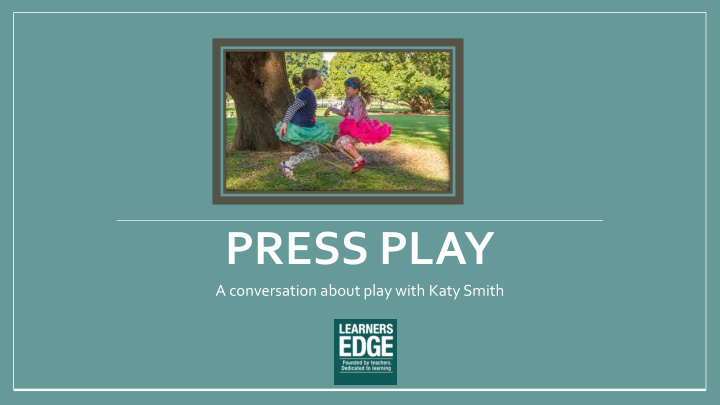



PRESS PLAY A conversation about play with Katy Smith
Susanne Leslie, Interviewer • Proud mother of a recent UW Badger graduate and a U of M Golden Gopher senior • Loves anything and everything outdoors – during all four Minnesota seasons Former parent educator • • Has been with Learners Edge for ten years Current Role: Lead Curriculum & Instruction Specialist at • Learners Edge www.LearnersEdgeInc.com
www.LearnersEdgeInc.com
Connector, Story-Teller, Play Advocate & 2011 Minnesota Teacher of the Year Katy Smith • Lives in Winona, Minnesota with her husband, Matt • 3 grown daughters and 2 brand new sons-in-law • First parent educator to be honored with the Teacher of the Year Award • Undergraduate degrees in social work and parent education • Licensed parent educator • Master’s in Education • Master’s in Early Childhood Public Policy and Advocacy www.LearnersEdgeInc.com
www.LearnersEdgeInc.com
“Do something every day that scares you.” Eleanor Roosevelt www.LearnersEdgeInc.com
“ For more than fifty years, children's free play time has been continually declining, and it's keeping them from turning into confident adults.” (Gray, 2011) www.LearnersEdgeInc.com
www.LearnersEdgeInc.com
“ Play is the highest form of research.” Albert Einstein www.LearnersEdgeInc.com
PLAY DOH is RIGOR! Hand strength Dexterity Pincer grip www.LearnersEdgeInc.com
Trust the Research. • Play teaches children are in control of their own life, they learn to solve problems, experience joy, how to get along, empathy, how to get over narcissism--and by definition teaches creativity and innovation. • Play is nature’s means of ensuring that young mammals, including young human beings, acquire the skills that they need to acquire to develop successfully into adulthood. • Play in the classroom fosters improvements in such subjects as mathematics, language, early literacy, and socio- emotional skills, and it does so for children from both low and higher income environments. • Because play’s benefits are so extensive, play has been asserted as a revolutionary and developmentally important activity. • Play should be viewed as a valuable classroom activity that enables children to develop a wide variety of social and academic skills. • Through play, children learn how to get along with others, solve problems, inhibit their impulses, and regulate their emotions. • In play, children make friends and learn to get along with others as equals. (Gray, 2011; Lewis, 2015) www.LearnersEdgeInc.com
If the research states play is the foundation to learning… Why, then, is play the first thing to go? www.LearnersEdgeInc.com
Too many schools place a double burden on young children. First they heighten their stress by demanding that they master material beyond their developmental level. Then they deprive children of their chief means of dealing with that stress – creative play. (Miller & Almon, 2009) www.LearnersEdgeInc.com
www.LearnersEdgeInc.com
Teacher Comments: • If playing is happening in my classroom I am looked down upon • I’ve been told my students should be in their seats doing pencil and paper work to prepare for first grade • Pressure not to play often came from principals whose background was in high school teaching and have no experience with early childhood education • An administrator told me “you are going to stop singing and start teaching, right?” • Teachers feel pressure to call play centers “developmental centers,” “work centers” or to describe play as “active learning” • A teacher suggested that dramatic play centers should be removed from kindergarten classrooms because “there is a time crunch and not enough time to spend on things.” (Gray, 2011; Lewis, 2015) P = Project L = Learning A = All Y = Year www.LearnersEdgeInc.com
“NECESSITY MAY BE THE MOTHER OF INVENTION BUT PLAY IS MOST CERTAINLY THE FATHER.” Roger von Oech, A Whack on the Side of the Head
Daniel Pink, A Whole New Mind www.LearnersEdgeInc.com
Google campus www.LearnersEdgeInc.com
“SITTING STILL AND BEING QUIET IS NOT A MARKETABLE JOB SKILL.” Diane Trister Dodge, The Creative Curriculum
www.LearnersEdgeInc.com
“Whatever the brain is doing while apparently doing nothing may actually be profoundly important.” www.LearnersEdgeInc.com
www.LearnersEdgeInc.com
Center for Disease Control 12.7 million 1 in 6--children www.LearnersEdgeInc.com
Teach Yourself to Play, too! • Play can be a tough concept to grasp if one has never played. • Self-directed play can feel foreign to young teachers who grew up with cell phones and organized sports. • It’s important for our students, and it is just as www.LearnersEdgeInc.com important for us . (Miller & Almon, 2008)
Become a Play Warrior. www.LearnersEdgeInc.com
Learn about play! www.LearnersEdgeInc.com
Become an advocate for early childhood education! • https://www.youtube.com/watch?v=6xMsPYYtkBg www.LearnersEdgeInc.com
Add play to your classroom (and your life)! www.LearnersEdgeInc.com
Questions? www.LearnersEdgeInc.com
Twitter: KatyMN12 Facebook: KatySmithWinona Website: KatySmithMN www.LearnersEdgeInc.com
References: • At Google a Place to Work and Play (2012, March 16). Retrieved from http://www.nytimes.com/2013/03/16/business/at-google-a-place-to-work-and-play.html Retrieved 12/2016. • Childhood Obesity Data. Center for Disease Control. Retrieved from https://www.cdc.gov/obesity/data/childhood.html Retrieved 12/2016. • Dodge, T. D. (2010). Research Foundation: The Creative Curriculum. www.teachingstrategies.com • Gray, P. (2011). The Decline of Play and the Rise of Psychopathology in Children and Adolescents. American Journal of Play. www.journalofplay.org • Lewis, L. (2016). Play: The foundation of children’s learning. Red Leaf Press. St. Paul, MN. • Lynch, M. (2015). More Play, Please: The perspective of kindergarten teachers on play in the classroom. American Journal of Play. www.journalofplay.org • Miller, E., & Almon, J. (2009). Crisis in Kindergarten: Why children need to play in school. Alliance for Childhood. Video Resources: • https://www.zerotothree.org/resources/250-everyday-fun-with-shapes-let-s-talk-about-math-video • https://www.youtube.com/watch?v=H_XR4wJU90A • http://www.naeyc.org/tyc/teaching-learning-hip-hop • https://www.facebook.com/pg/KatySmithWinona/videos/ www.LearnersEdgeInc.com
Recommend
More recommend